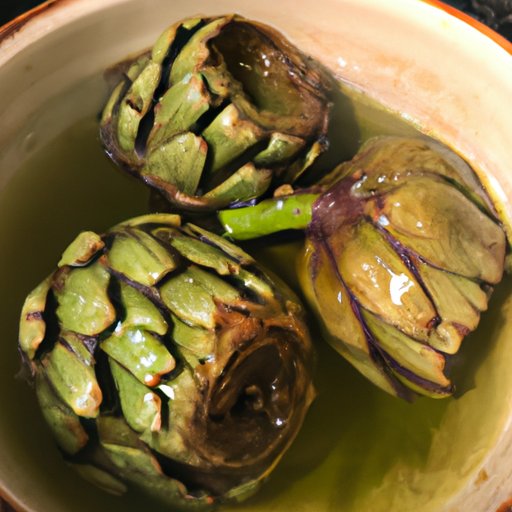
Introduction
Artichokes are a delicious and healthy addition to any meal, but they can be a challenge to cook. Many people find themselves unsure of how to prepare and boil them correctly, which can lead to a less than satisfying culinary experience. This article will guide you through each step of boiling artichokes to perfection, along with tips for maximizing their health benefits, pairing them with other foods, and cooking them more quickly.
Step-by-Step Guide: How to Boil Artichokes
To boil artichokes successfully, the following steps must be followed:
Overview of equipment needed
The only essential tools for boiling artichokes are a pot for boiling water and a strainer to remove the artichokes from the pot.
Washing and trimming artichokes
Start by rinsing the artichokes under warm water and then trim the stem to 1/2 inch. Starting from the top of the artichoke, cut 1-2 inches off the leaves’ tip.
Preparing a pot of water
Fill a pot with enough water to cover the artichokes completely. Add a generous amount of salt and the juice of half a lemon to the water to add flavour to the artichokes.
Boiling artichokes
Place the pot on the stove and bring it to a boil. Add the trimmed artichokes to the pot and boil them for about 30 minutes or until they are tender.
Straining and serving the artichokes
Remove the pot from the heat and transfer the artichokes to a strainer to drain off excess water. Serve the boiled artichokes with melted butter, mayonnaise, or your chosen sauce.
Health Benefits of Boiled Artichokes
Nutritional content of artichokes
Artichokes are rich in antioxidants, fiber, and vitamins K, C, and B6. Boiling artichokes preserves much of the vegetable’s nutritional value, making them an excellent addition to a healthy diet.
Explanation of how boiling preserves artichoke nutrients
The boiling process helps preserve the artichokes’ nutrients by breaking down their cell walls and releasing many of their vitamins and minerals. Boiled artichokes are also easier to digest, making it easier for the body to absorb them.
Suggestions for maximizing nutritional value
To maximize the nutritional value, avoid overcooking the artichokes, as overcooking can cause the nutrients to break down and wash away in boiling water.
Tips for incorporating artichokes into a healthy diet
Artichokes can be incorporated into any healthy diet by adding them to salads, pasta dishes, and soups. They also make an excellent side dish when served with grilled chicken or fish.
Flavor Pairings
Introduction to flavor pairings
The unique flavor and texture of artichokes make them an ideal partner for a variety of foods.
Suggestions for savory pairings
Artichokes pair well with savory foods such as garlic, cheese, olives, and roasted tomatoes. Incorporating these ingredients into boiled artichokes can enhance their flavor and add variety to your cooking routine.
Suggestions for more tangy pairings
For those who prefer a tangier flavor, try pairing artichokes with lemon juice, capers, and anchovies. The combination of these ingredients not only enhances the taste but also provides an extra dose of healthy nutrients to your dish.
Discussion of how different seasonings and sauces can enhance artichoke flavor
Seasonings such as rosemary, thyme, and oregano can add a fragrant kick to boiled artichokes, while sauces like hollandaise or aioli can provide more creaminess and richness.
Regional Cuisine
Overview of artichoke dishes from different global regions
Artichokes are a popular vegetable worldwide, and there are many ways to prepare them, depending on the region.
Detailing 2 or 3 specific regional dishes
Greek artichoke recipes such as the “Aginares a la Polit” is typically made by slow-cooking the artichokes with carrots, potatoes, and peas with olive oil, lemon juice, and dill. In Spain, the “Menestra de Verduras” includes boiled artichokes cooked with asparagus, peas, and carrots in a tomato sauce.
Discussion of how different regions prepare artichokes and how cultural tastes differ
Artichoke dishes can vary widely between cultures, depending on ingredients and cooking methods. For example, Italians prepare artichokes by stuffing them with breadcrumbs, garlic, and anchovy paste, while French cuisine has dishes that include artichokes gratin with cream and cheese. It’s good to experiment with various regional recipes to find the ones that match your preferences.
Time-Saving Tips
Acknowledgment of the common problem people have with time constraints
It’s common to feel short on time when it comes to cooking on a busy day. But with these time-saving tips, you can still cook artichokes without spending too much time.
Explanation of how to cook artichokes faster
Cooking artichokes in a pressure cooker or using a microwave can shorten cooking time. You can cook artichokes in the microwave in just 10 minutes by wrapping it in wet paper towels and microwaving it on high until it’s tender.
Suggestions for different cooking tools that shorten prep time
If you’re looking for other time-saving ideas, consider investing in a vegetable steamer or an Instant Pot for hassle-free preparation. Another useful tool includes the artichoke slicer for trimming, peeling, and removing the choke.
Tips on meal-prepping artichokes in bulk
Consider making boiled artichokes in advance & storing them in an airtight container in the fridge, which can save time on meal prep. Boiled artichokes can also be frozen and used later in dips and casseroles.
Conclusion
Boiling artichokes can be a quick and straightforward process once you know the tricks. Take advantage of the many health benefits of artichokes by experimenting with flavor pairings, regional recipes, and adopting time-saving tips like meal-prepping. Remember that the artichoke is more than just a vegetable—it’s a versatile kitchen staple that can add unique flavor and enhance the texture of your meals.





